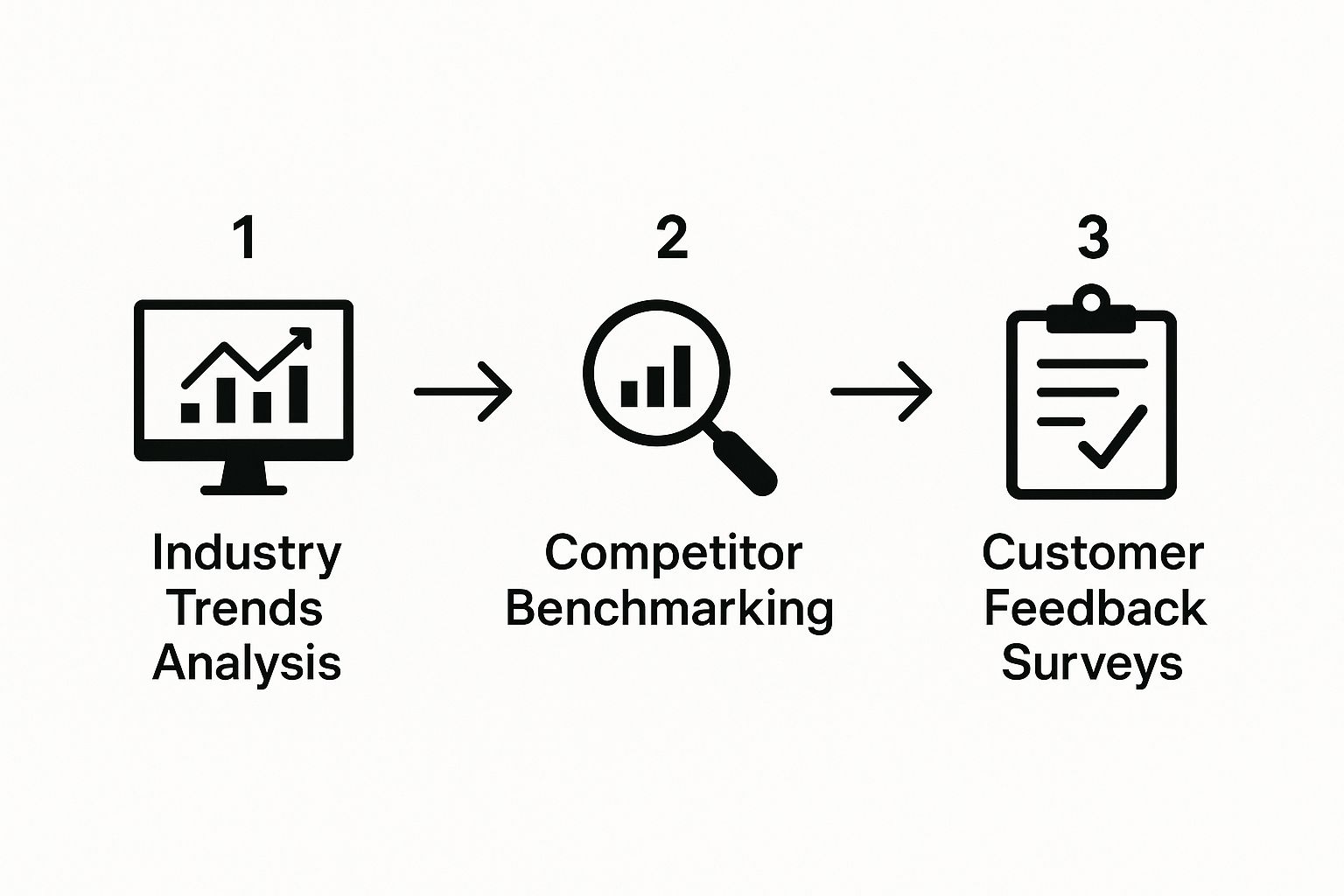Navigating the Competitive SaaS Marketing Landscape
Building a winning SaaS marketing plan today feels completely different than it did just five years ago. What used to be a niche way to deliver software has exploded, becoming the standard for how modern businesses get things done. This isn't just a small change; it's a massive shift that forces us to rethink marketing from the ground up. The old playbooks, which were all about one-time sales and long feature lists, just don't work in a world driven by subscriptions and long-term customer value.
The Great Subscription Shift
The biggest challenge—and the biggest opportunity—is the subscription model itself. You're not just selling a piece of software; you're selling a relationship and a promise of ongoing results. This changes how customers think. They aren't making a huge, one-off investment. Instead, they're making a smaller, recurring one, which means they are constantly asking, "Is this still worth it?"
A successful SaaS marketing plan understands that the real work starts after someone signs up. Keeping customers isn't a separate job for a different team; it's a core part of marketing. After all, it costs far more to find a new customer than to keep an existing one happy. This reality creates unique hurdles, like longer sales cycles with more people involved and the constant fight to keep churn rates low.
Understanding Today's Market Dynamics
The sheer size of the SaaS market shows just how intense the competition is. The global SaaS industry didn't just grow; it ballooned by an incredible 500% between 2013 and 2020. And it's not slowing down. Projections show the market could hit an eye-watering $793.1 billion by 2029. This isn't just a number—it represents a very crowded room where your message has to be incredibly sharp to cut through the noise. You can dig into the data behind this growth to get a better feel for the space you're in.
This chart really drives the point home, showing a market that's not just big, but also speeding up.
This visual makes it clear: more and more competitors are going to keep jumping in.
Why Yesterday's Tactics Fail
So, what does all this growth mean for your marketing strategy? It means generic, one-size-fits-all tactics are useless. It used to be that a company could get by just by having a few more features than the next guy. Today, with countless alternatives just a quick search away, you have to stand out in a much more meaningful way.
Smart SaaS marketers are ditching old habits and embracing new approaches:
- Beyond Feature-First Marketing: Instead of just listing what your product does, show people the transformation it delivers. How does it make their workday easier, their business more profitable, or their team more collaborative?
- Breaking Down Silos: The customer journey isn't a straight line anymore. Marketing needs to be everywhere—from the first blog post a person reads to the in-app messages they see during onboarding. It has to be one smooth, connected experience.
- Ditching "Set It and Forget It" Campaigns: The best strategies are built on a cycle of constant learning and tweaking. You should always be testing your messaging, channels, and offers to see what truly connects with your audience.
Ultimately, building a modern SaaS marketing plan is about embracing this new reality. It demands a deep understanding of your ideal customer, a clear way of communicating your value, and a relentless focus on building trust and proving your worth over the entire time a customer is with you.
Building Customer Profiles That Actually Guide Decisions
Let's be honest: most buyer personas are useless. They’re often built on assumptions, filled with generic details like "Reads tech blogs," and then filed away, never to influence a single marketing dollar. To build a SaaS marketing plan that drives real growth, you need to go deeper and create customer profiles that act as a compass for your entire strategy, not just a slide in a presentation deck.
This process isn't about guesswork; it's about investigation. It starts with a blend of qualitative and quantitative research. You need to talk to real people and dig into your user data to find the patterns that separate your most successful, high-value customers from those who churn after a few weeks. Without this foundation, you’re just creating fiction.
From Vague Personas to Actionable Segments
The goal isn't just to create one "ideal customer" but to identify distinct segments within your user base. Each segment has different motivations, pain points, and definitions of success. Trying to speak to all of them with the same message is a recipe for being ignored.
Start by analyzing your existing user data. Who are the users with the highest customer lifetime value (CLV)? What about the ones who adopt new features the fastest or refer others? Look for common threads:
- Company Size: Are your best customers scrappy startups or established mid-market companies?
- Industry Vertical: Do you see clusters in specific industries like e-commerce, healthcare, or finance?
- Use Case: How are they actually using your product? It might be different from how you designed it.
This process involves gathering insights from industry trends, competitor actions, and direct customer feedback to inform your strategy.

This flow highlights that strong customer profiles are built on a continuous cycle of external analysis and internal feedback, not a one-time project.
Conducting Interviews That Reveal Truths
Data tells you what is happening, but conversations tell you why. Customer interviews are essential, but you have to ask the right questions. Avoid leading questions like, "Don't you just love our new dashboard?" Instead, ask open-ended questions that uncover their reality:
- "Walk me through how you accomplished [task] before you started using our software."
- "What was happening in your business that made you start looking for a solution like ours?"
- "If our product disappeared tomorrow, what would be the most frustrating part of your day?"
These questions get to the core of their pain and the value you provide. To truly guide decisions, building customer profiles must integrate with your broader content strategy. This emphasizes the importance of defining buyer personas for content strategy and ensuring every piece of content speaks directly to a specific segment's needs.
Once you have these insights, you can create a simple framework that connects each segment to concrete marketing actions. The table below offers a practical example of how to organize this information, turning abstract profiles into a tool that guides everything from ad copy to channel selection.
Customer Segmentation Framework for SaaS Companies
A comprehensive breakdown of key customer segments with characteristics, pain points, and marketing approaches for each
| Segment | Company Size | Primary Pain Points | Marketing Channels | Messaging Focus |
|---|---|---|---|---|
| The Startup Hustler | 1-10 employees | Limited budget, lack of specialized skills, need for quick wins and efficiency. | Product-led growth (freemium), social media (LinkedIn, Twitter), community forums. | "Get started for free," "Save 10 hours a week," "The all-in-one solution for small teams." |
| The Scale-Up Leader | 11-100 employees | Inefficient workflows, scaling challenges, need for collaboration tools and process automation. | Content marketing (blog, webinars), paid search (Google Ads), software review sites (Capterra, G2). | "Scale your operations," "Streamline team collaboration," "Integrate with your existing tools." |
| The Mid-Market Manager | 101-500 employees | Data silos between departments, security and compliance concerns, need for robust reporting and analytics. | Account-based marketing (ABM), LinkedIn advertising, targeted email outreach. | "Centralize your data," "Enterprise-grade security," "Unlock actionable insights with advanced reporting." |
This framework isn't just an exercise; it's a practical tool. It ensures your marketing efforts are targeted and relevant, preventing you from shouting into the void. It’s the difference between marketing with a map and just wandering in the dark.
Developing Messaging That Cuts Through Market Noise

Now that you have a clear picture of who you’re talking to, the next part of your SaaS marketing plan is figuring out what to say. This goes way beyond crafting a clever tagline. We're talking about defining the core value that will steer every single marketing move you make. In a jam-packed market, generic promises about being "secure" or "efficient" are completely invisible. Your prospects have heard it all a thousand times.
Your mission is to paint a picture of a specific, desirable outcome so clearly that your ideal customer thinks, "Wow, they built this just for me." This means you need to stop talking about what your product does and start showing what your customer can achieve with it. Instead of a laundry list of features, focus on the transformation. It's the difference between saying, "Our software has a project management dashboard," and "Our software helps marketing teams ship campaigns 30% faster by eliminating approval bottlenecks." The first is a feature; the second is a real result.
From Features to Outcomes
To make this switch, try translating your features into benefits, and then into tangible outcomes. This simple exercise can totally reshape how you talk about your product.
Let's walk through an example:
- Feature: One-line code install for an affiliate program.
- Benefit: It’s easy and quick to set up.
- Outcome: Launch a fully native referral program in minutes, not weeks, without needing to pull in a developer.
This outcome-driven message makes your value crystal clear. It connects your product directly to a major headache—the slow, developer-heavy process of launching traditional affiliate programs. That's the kind of messaging that stops someone mid-scroll and makes them want to know more. Companies like Dropbox and Asana are masters of this, often using a "freemium" model, which is powerful marketing in itself. Their message is a direct invitation to experience the outcome firsthand, completely risk-free.
The A/B Test for Messaging Resonance
So you’ve drafted what you think is killer messaging. How do you actually know if it's any good? You have to test it. Gut feelings are great, but real audience feedback is the only way to know if your message is hitting the mark or falling flat.
Here are a few practical ways to test and fine-tune your messaging:
- Landing Page A/B Tests: Set up two versions of a landing page with different headlines and value propositions. Drive some paid traffic to both and see which one gets more demo requests or sign-ups.
- Email Subject Lines: Experiment with different outcome-focused subject lines in your email campaigns. Your open rates will tell you which message is more compelling.
- Customer Interviews: Pay close attention during sales calls and customer check-ins. Listen to the exact words your customers use to describe their problems and the value they get from your product. They'll often hand you the perfect marketing copy on a silver platter.
It’s also worth noting that, according to research from Wyzowl, 66% of customers would rather watch a video than read about a product. This gives you another great channel for testing short, engaging video content centered around your key messages.
The end goal is simple: find the language that makes your ideal customer nod in agreement. A strong message is the bedrock of a successful SaaS marketing plan because it makes every other activity, from writing blog posts to running ad campaigns, infinitely more effective.
Creating Your Marketing Analytics Foundation
Successful SaaS marketing runs on data, not hunches. Yet, a lot of teams find themselves drowning in metrics that look impressive on a slide but don’t actually guide decisions. To build a marketing plan that lasts, you need an analytics foundation that cuts through the noise and zeroes in on what truly matters for growth. It’s all about setting up systems that give you real insights, from lead quality to customer lifetime value (CLV), without getting lost in feel-good numbers.

This data-first approach isn't just a "nice-to-have" anymore. With the global SaaS market projected to hit $232 billion in 2025, the pressure on marketing teams to back up their strategies with hard data is immense. Simply relying on intuition won't cut it when the competition is this fierce and every marketing dollar needs to be accounted for. You can discover more insights about SaaS trends that show why rigorous data analysis is becoming a key separator for successful companies.
Moving Beyond Vanity Metrics
The first hurdle is learning to tell the difference between vanity metrics and actionable metrics. Vanity metrics, like total social media followers or page views, might stroke the ego but often have little to do with revenue. Actionable metrics, on the other hand, are tied directly to your business goals and tell you if your strategy is actually working.
For instance, instead of just tracking overall website traffic, a more powerful approach is to monitor traffic-to-trial conversion rates for each marketing channel. This tells you not just how many people are visiting, but which sources are bringing in high-intent prospects who are genuinely interested in your product. Getting this right means you're not just reporting on activity; you're measuring impact. For anyone looking to get sharper here, mastering key marketing metrics is a vital skill.
Your Core SaaS Marketing Dashboard
A great dashboard doesn't just display data; it tells a story and drives action. It should give you a clear, at-a-glance view of the health of your entire marketing funnel. While the specifics will change based on your business model (product-led vs. sales-led, for example), every SaaS dashboard should track the full customer journey.
To get you started, here’s a look at the essential performance indicators every SaaS marketing team should have on their radar. This table breaks down what they are, why they matter, and how to improve them.
Essential SaaS Marketing Metrics Dashboard
Key performance indicators every SaaS marketing team should track, with benchmarks and optimization strategies
| Metric | Definition | Industry Benchmark | Tracking Frequency | Optimization Tactics |
|---|---|---|---|---|
| Marketing Qualified Leads (MQLs) | A lead deemed more likely to become a customer based on their behavior (e.g., downloaded an ebook, requested a demo). | Varies by industry, but focus on consistent month-over-month growth. | Weekly / Monthly | Refine content offers, improve landing page copy, A/B test calls-to-action. |
| Customer Acquisition Cost (CAC) | The total cost of sales and marketing to acquire a new customer over a specific period. | Should be significantly lower than your CLV (ideally 1/3 or less). | Monthly / Quarterly | Optimize ad spend on high-performing channels, improve conversion rates to reduce cost per lead. |
| Customer Lifetime Value (CLV) | The total revenue you can expect from a single customer account throughout your business relationship. | Aim for CLV to be at least 3x your CAC. | Quarterly / Annually | Increase retention with better onboarding, upsell/cross-sell valuable features, implement loyalty programs. |
| CLV:CAC Ratio | The ratio of customer lifetime value to customer acquisition cost. | A healthy SaaS business typically aims for 3:1 or higher. | Monthly / Quarterly | Focus on acquiring higher-value customers, reduce churn, and lower acquisition costs simultaneously. |
| Customer Churn Rate | The percentage of customers who cancel their subscriptions over a specific period. | 5-7% annually is a good target for most SaaS companies. | Monthly | Proactively engage at-risk users, gather feedback from canceled accounts, improve product value. |
| MQL-to-SQL Conversion Rate | The percentage of MQLs that the sales team accepts as qualified leads (Sales Qualified Leads). | 10-15% is a common benchmark, but depends heavily on lead scoring alignment. | Weekly / Monthly | Improve lead scoring criteria, ensure marketing and sales have a shared definition of a "good lead." |
This table serves as a solid starting point for building a dashboard that truly informs your strategy. By focusing on these core metrics, you can ensure your marketing efforts are not just busywork but are actively contributing to sustainable growth.
Building this foundation isn't a one-and-done project. It’s about fostering a culture of continuous testing and optimization where data informs every decision. When you focus on these metrics, you shift from simply being busy to being effective, ensuring your SaaS marketing plan is built on a solid framework that can adapt and scale as your company grows.
Building Multi-Channel Acquisition That Actually Works
Relying on a single marketing channel today is like fishing with only one type of bait—you might catch something, but you're leaving most of the fish in the sea. A modern SaaS marketing plan needs a multi-channel approach. But this isn't about spreading your budget thin across every platform you can think of. The real art is in creating campaigns where each channel supports the others, creating a seamless experience that meets people wherever they are.
The goal is synergy, not a fight for attribution. Your paid search, content, and social efforts shouldn't be competing. Instead, they should work together. For instance, a prospect might first find your brand through a blog post on Google. Later, they see a targeted ad on LinkedIn based on that visit, which prompts them to follow your page. This sequence feels natural and builds trust over time.
Choosing Your Core and Experimental Channels
Not all channels are created equal, especially for SaaS. Your product, price, and ideal customer will dictate where you should put your energy. For a product-led growth (PLG) company with a low-cost, self-serve product, channels that scale efficiently are your best bet.
- Content Marketing & SEO: This is the foundation for many SaaS businesses. Creating genuinely helpful, problem-solving content establishes you as an authority and attracts organic traffic from people actively looking for answers. It's a long-term play, but the compound interest it generates is incredible.
- Paid Social & Search (PPC): These channels are great for targeting specific groups and driving immediate actions, like free trial sign-ups. The key is to get specific. On LinkedIn, for example, you can target by job title, company size, and industry to reach the exact decision-makers you've identified.
- Strategic Partnerships: This can be anything from co-marketing webinars with complementary SaaS companies to full-on integration partnerships. These let you tap into an established, relevant audience and borrow credibility from a trusted brand.
A smart way to manage your budget is to allocate the majority—say, 80%—to these proven, core channels that consistently deliver. The remaining 20% becomes your "experimental" fund. Use it to test out emerging channels like niche communities, industry newsletters, or new ad platforms without risking your main source of leads.
Orchestrating the Customer Journey
Once you’ve picked your channels, you need to map out how they connect. A person's journey to becoming a customer is rarely a straight line. They might bounce between your blog, social media, and email over weeks before they're ready to commit. Your job is to make that journey feel effortless.
Here’s a real-world scenario for a project management SaaS:
- Awareness (Content/SEO): A marketing manager searches "how to improve team collaboration remotely" and discovers your in-depth guide.
- Consideration (Paid Social): A few days later, they see a LinkedIn ad for your webinar on "The Top 5 Project Management Bottlenecks and How to Fix Them." They recognize your brand from the blog post and decide to sign up.
- Evaluation (Email & Review Sites): After the webinar, they get a targeted email sequence. Now curious, they look up reviews of your product and see positive feedback on sites like G2 and Capterra.
- Conversion (Referral): Before starting a trial, they ask a colleague for a recommendation. That colleague, who is already a happy customer, sends them a referral link, giving them both a discount. This final nudge from a trusted source seals the deal.
This integrated approach works because it builds trust at multiple points. It also shows the importance of channels that are easy to overlook. For example, many companies discover that a solid referral program can become one of their best acquisition loops. If you want to explore this further, check out these proven referral marketing strategies that can turn your customers into a powerful growth engine.
Ultimately, a multi-channel strategy isn't just about showing up everywhere. It’s about telling a consistent story that guides people from their first flicker of curiosity to becoming enthusiastic advocates for your product.
Mastering Onboarding and Retention Marketing
Getting new customers through the door is a great feeling, but the real, sustainable profit in SaaS comes from keeping the customers you already have. This is where your SaaS marketing plan pivots from acquisition to activation and retention. It's the moment you deliver on your product's promise and turn a fresh sign-up into a long-term, happy user. Skipping this part is like spending a fortune to fill a leaky bucket; you'll be working hard but never see it get full.
The first few moments a customer spends with your product are incredibly important. This goes way beyond sending a generic "welcome" email. It's about crafting an onboarding experience that leads users directly to their first "aha!" moment—that magical point where they truly get how your software solves their problem. A thoughtful onboarding sequence drives immediate product adoption and seriously cuts down the risk of early churn.
Driving Adoption From Day One
Effective onboarding is a core marketing function. It starts with a deep understanding of what success looks like for your new users and then building clear pathways to get them there fast. This usually involves a mix of tactics:
- Triggered Email Sequences: Don't just send one welcome email. Create a series that introduces key features based on what the user is (or isn't) doing. For instance, if a user hasn’t invited a teammate after three days, send a friendly email highlighting the benefits of collaboration.
- In-App Guided Tours: Use tooltips and pop-ups to point out high-value features during their first session. This helps users discover functions they might have otherwise missed.
- Educational Content Hub: Build a resource center with short video tutorials, help docs, and best-practice guides that empower users to find their own answers.
To get this right, it's worth exploring detailed SaaS onboarding best practices to make sure your strategy is solid from the very beginning.
This example from Intercom shows how in-app messages can nudge users toward valuable actions during their trial.

The main idea here is to use contextual, helpful prompts to encourage feature discovery and guide users toward hitting those key activation milestones.
Building Loyalty That Lasts
Once a user is activated, the game shifts to long-term retention. Keeping customers engaged means consistently showing them value and reminding them why they picked you in the first place. Proactive communication is your best friend here. You need to spot at-risk customers—those whose usage has dipped—before they think about canceling. A well-timed re-engagement campaign can often bring them back into the fold.
Email newsletters are a great tool for this. They aren't just for marketing to prospects; they're for nurturing your current customer base. Share product updates, customer success stories, and tips that help them get more from your tool. To make sure your customers stick around for the long haul, think about putting some proven email newsletter best practices into action.
Ultimately, a strong retention strategy is about making your customers feel seen and supported. It’s about creating helpful experiences that extend beyond the software itself. This approach not only slashes churn but also opens the door for upselling and cross-selling, turning satisfied users into your biggest fans. That’s how a smart SaaS marketing plan creates a powerful, self-sustaining growth loop.
Scaling Your Marketing Without Losing What Works
The scrappy, "do whatever it takes" approach that gets a SaaS startup off the ground has a shelf life. As you grow, the chaos that once felt like agility starts to feel like a liability. Your SaaS marketing plan must evolve from quick hacks to sustainable systems. The real challenge isn't just about doing more; it's about doing more without sacrificing the quality and personal touch that won you your first customers.
Scaling happens in phases. What worked for your first 100 customers will likely break when you're aiming for 1,000. Recognizing these inflection points is crucial. For instance, a single person managing all social media might be fine at the start, but as customer questions and engagement grow, you'll need a structured content production workflow. This isn't about adding bureaucracy; it’s about creating repeatable processes that ensure quality and consistency as your output increases.
Building Scalable Systems
To avoid painful growing pains, you need to intentionally build frameworks that can handle more complexity. This means shifting from ad-hoc campaigns to structured, repeatable systems. A great place to start is with your content engine. Instead of one person trying to handle brainstorming, writing, and publishing, create a clear workflow:
- Ideation: Use a shared system, like a simple Trello board or a dedicated channel, to capture ideas from sales, support, and direct customer feedback.
- Production: A content calendar is your best friend here. It should have clear deadlines, author assignments, and a simple editorial review process.
- Distribution: Don't let great content die after publishing. Create a checklist-driven process for promoting every piece of content across multiple channels—social media, email newsletters, community forums, etc.
This same logic applies to managing your campaigns. As you add more channels, a simple spreadsheet won’t be enough. Investing in a project management tool like Asana or a marketing automation platform becomes essential. This tech stack isn't just about efficiency; it gives you the visibility needed to manage multiple campaigns without dropping the ball.
Balancing Agility and Structure
A common fear when scaling is that processes will stifle creativity and innovation. The goal is to build a structure that supports agility, not one that crushes it. Research shows that 85% of SaaS companies using account-based marketing (ABM) see higher returns than with other methods. A successful ABM strategy demands tight coordination between sales and marketing—something that’s nearly impossible without a solid organizational framework. However, within that structure, teams should have the freedom to experiment with new messaging and tactics for their target accounts.
The key is to define what needs to be done (the strategic goals) while giving your team flexibility in how they achieve it. This is also where you must decide between building in-house teams and partnering with specialists. Early on, a generalist marketer is invaluable. As you scale, you might hire an SEO specialist or a paid ads manager in-house but partner with an agency for a high-effort project like a major brand video.
This balanced approach ensures you have dedicated expertise where it's most needed without bloating your permanent payroll. As you explore how to expand your marketing effectively, it’s helpful to review some fundamental SaaS growth strategies to ensure your scaling efforts align with proven principles for long-term success. The trick is to systematize the repeatable tasks so your team has more time to be creative and responsive.
Ready to add a powerful, scalable growth channel to your marketing mix? With Refgrow, you can launch a fully native affiliate program inside your SaaS in minutes. Start your free trial today and turn your best customers into your most effective marketing team.

